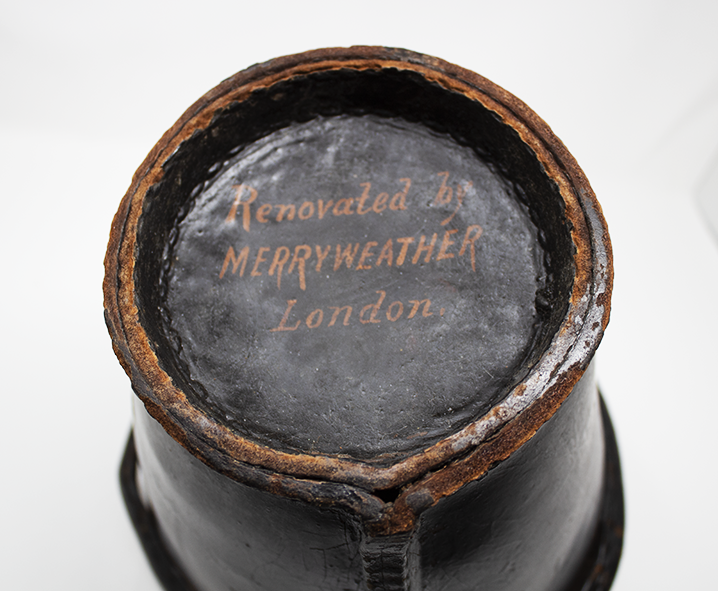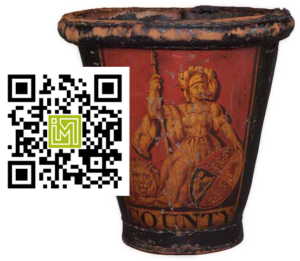County Fire Office


County Fire Office Bucket
This well-worn leather fire bucket of the County Fire Office was renovated by Merryweather. Whilst the fire engineering firm of Merryweather & Son was founded by Moses Merryweather in the first half of the 19th century, it can claim through a series of mergers to have been originally established in 1692, when Nathaniel Hadley set up a firm making primitive fire pumps. Their position as Britain’s leading fire engineers was finally confirmed in 1928, when they took over their main rival Shand Mason. Their involvement with this bucket would most likely have taken place in the late 19th century.
To see a digital model of the bucket, visit this link.

The County Fire Office, London 1807–1906
Emblem: It is said to be Britannia. However, earlier depictions of the female figure closely resemble the goddess Athene, a protective deity, and only later does she become recognisable as Britannia. The lion symbolises strength and security.
The founder of the company was John Thomas Barber Beaumont, a well-known painter of miniatures and pamphleteer.
It was established as ‘an association of noblemen and gentlemen’ with a subscribed capital of £300,000. This was one of the first London-based companies to underwrite country risks such as farm stock and hayricks. It had what at the time was a new method of attracting business, since it refunded a sum equal to 25 per cent of all premiums paid to every person who continued his insurance for seven years. This scheme was an innovation in fire insurance, and, being linked to a careful selection of risks, ensured the success of the project.
One of the first claims during the early years was from the Duke of Rutland. Fire broke out in 1816 at Belvoir Castle and caused £120,000 of damage. The whole ancient structure was reduced to ruins, and the board and the Duke were convinced that the fire was deliberate but were unable to prove it. Unfortunately the insured value was for less than the assessment of the damage caused.
The County’s London brigade consisted of a foreman, deputy foreman, engineer, two firemen and five ‘super-numeries’, all recruited from among the Thames watermen. Until 1817 the engine was situated in the yard of the Old Bell Tavern in the Strand.
Barber Beaumont was well aware of the advertising value of fire marks, as in 1821 he wrote in a letter to a County agent: ‘In passing through Halifax last week … I did not observe any of our marks up … which I wondered at. Pray employ a man to … fix them on all buildings insured with us.”
Agrarian unrest between 1820 and 1840 led to many outbreaks of arson. In 1835 losses on farm stock exceeded premium income, and it was not until the 1840s that profits recovered. The company continued to expand until 1906, when the County became allied with the Alliance Assurance Company.
Registered Charity address:
C/o Chartered Insurance Institute
3rd Floor, 20 Fenchurch Street,
London EC3M 3BY
Charity No. 1188138
Sign up to Newsletter
© Copyright Insurance Museum 2022
